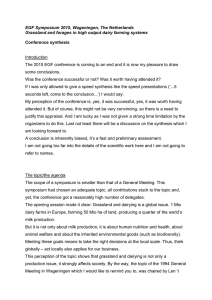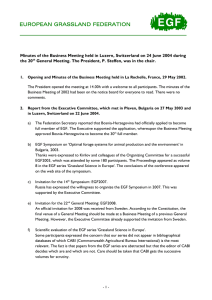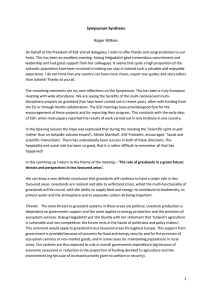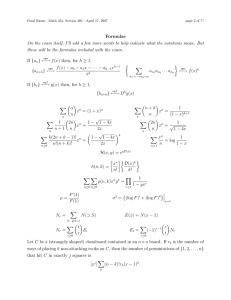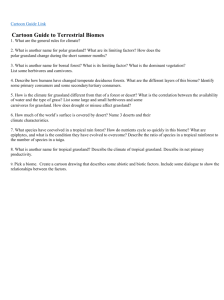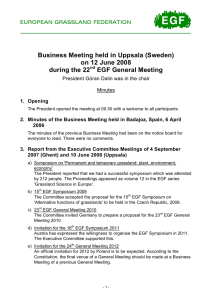A history of the European Grassland Federation, 1963–2003 Abstract W. H. Prins
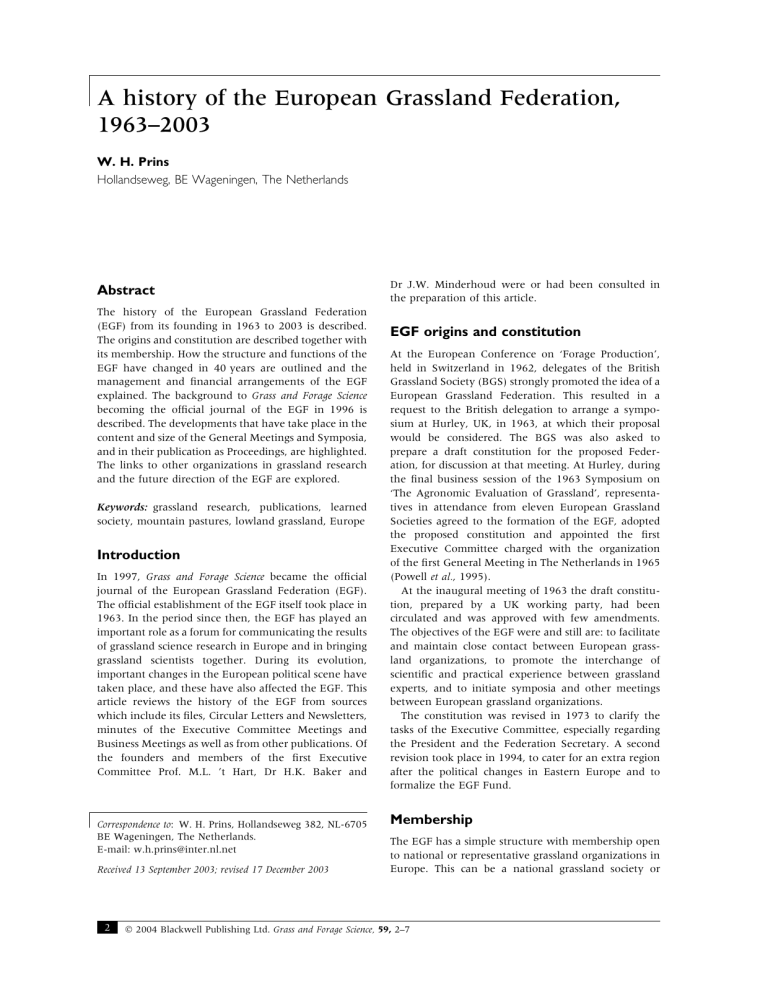
A history of the European Grassland Federation,
1963–2003
W. H. Prins
Hollandseweg, BE Wageningen, The Netherlands
Abstract
The history of the European Grassland Federation
(EGF) from its founding in 1963 to 2003 is described.
The origins and constitution are described together with its membership. How the structure and functions of the
EGF have changed in 40 years are outlined and the management and financial arrangements of the EGF explained. The background to Grass and Forage Science becoming the official journal of the EGF in 1996 is described. The developments that have take place in the content and size of the General Meetings and Symposia, and in their publication as Proceedings, are highlighted.
The links to other organizations in grassland research and the future direction of the EGF are explored.
Keywords: grassland research, publications, learned society, mountain pastures, lowland grassland, Europe
Introduction
In 1997, Grass and Forage Science became the official journal of the European Grassland Federation (EGF).
The official establishment of the EGF itself took place in
1963. In the period since then, the EGF has played an important role as a forum for communicating the results of grassland science research in Europe and in bringing grassland scientists together. During its evolution, important changes in the European political scene have taken place, and these have also affected the EGF. This article reviews the history of the EGF from sources which include its files, Circular Letters and Newsletters, minutes of the Executive Committee Meetings and
Business Meetings as well as from other publications. Of the founders and members of the first Executive
Committee Prof. M.L. ’t Hart, Dr H.K. Baker and
Dr J.W. Minderhoud were or had been consulted in the preparation of this article.
EGF origins and constitution
At the European Conference on ‘Forage Production’, held in Switzerland in 1962, delegates of the British
Grassland Society (BGS) strongly promoted the idea of a
European Grassland Federation. This resulted in a request to the British delegation to arrange a symposium at Hurley, UK, in 1963, at which their proposal would be considered. The BGS was also asked to prepare a draft constitution for the proposed Federation, for discussion at that meeting. At Hurley, during the final business session of the 1963 Symposium on
‘The Agronomic Evaluation of Grassland’, representatives in attendance from eleven European Grassland
Societies agreed to the formation of the EGF, adopted the proposed constitution and appointed the first
Executive Committee charged with the organization of the first General Meeting in The Netherlands in 1965
(Powell et al.
, 1995).
At the inaugural meeting of 1963 the draft constitution, prepared by a UK working party, had been circulated and was approved with few amendments.
The objectives of the EGF were and still are: to facilitate and maintain close contact between European grassland organizations, to promote the interchange of scientific and practical experience between grassland experts, and to initiate symposia and other meetings between European grassland organizations.
The constitution was revised in 1973 to clarify the tasks of the Executive Committee, especially regarding the President and the Federation Secretary. A second revision took place in 1994, to cater for an extra region after the political changes in Eastern Europe and to formalize the EGF Fund.
Correspondence to : W. H. Prins, Hollandseweg 382, NL-6705
BE Wageningen, The Netherlands.
E-mail: w.h.prins@inter.nl.net
Received 13 September 2003; revised 17 December 2003
Membership
The EGF has a simple structure with membership open to national or representative grassland organizations in
Europe. This can be a national grassland society or
2
2004 Blackwell Publishing Ltd.
Grass and Forage Science, 59, 2–7
A history of the European Grassland Federation, 1963–2003 3 association, a national grassland institute or an academy of agricultural science.
In October 1964, ten countries had officially confirmed their membership: Belgium, Denmark, the
Federal Republic of Germany, Finland, France, Ireland,
Italy, The Netherlands, Switzerland and the United
Kingdom, to be followed in 1965 by the German
Democratic Republic, Norway, Poland and Sweden
(Baker, 1965). The EGF had grown to eighteen full members by 1980, twenty by 1982, twenty-one by 1987 and, following the political changes in
Eastern Europe, has twenty-nine full members in
2003 (Table 1).
For those countries without a national or representative organization, the revised constitution of 1973 states that ‘at the discretion of the Executive Committee, individual grassland workers may become Corresponding Members of the Federation, provided that they are resident in a European country or territory and that the country or territory does not have a national or representative organization which has membership of the Federation’. In 2003 the EGF had eight corresponding members, namely individual grassland workers who serve as contact persons in countries without a national or representative organization (Table 1). Membership of the EGF is gratis.
Contact with individual grassland workers is maintained through a representative in each country, often the secretary of the national grassland society. These representatives act as intermediaries between their national colleagues and the Federation Secretary and
Organizing Committees of EGF conferences.
Executive Committee
The first Executive Committee, elected at Hurley in
1963, consisted of Prof. M.L. ‘t Hart (The Netherlands),
Dr H.K. Baker (UK), Mr J. Rebischung (France), Mr
B.R. Bentholm (Denmark) and Dr J. Caputa (Switzerland). Dr J.W. Minderhoud (The Netherlands) joined later as Secretary.
According to the Constitution: ‘The affairs of the
Federation shall be managed by an Executive Committee which shall consist of: The President … , the immediate Past-President … , the Secretary of the next
General Meeting … , one member to represent the EGF regions … , the Federation Secretary but who shall not have a vote … ’. With an increasing number of regions, the Executive Committee has grown and since 1992 has consisted of eleven people.
In the early years, the Executive Committee convened quite frequently, but subsequently has met only during EGF conferences and occasionally during other related conferences, for instance an International
Grassland Congress. The composition of the Executive
Committee has also changed: in the first 20 years there was a high proportion of professors, which led to discussions on issues such as ‘standardization of methods’ and ‘grassland terminology’. In recent years the discussions have mainly been centred around organizational matters.
Honorary Life Presidents
Dr W. Davies, the great stimulator and founding father of the EGF, was voted the first Honorary Life President at the inaugural meeting in 1963 and, until his death in
1968, Dr Davies played an active role in the EGF
(Powell et al.
, 1995).
Two further Honorary Life presidents were elected in
1980. Prof. M.L. ‘t Hart had been the EGF’s first
President, and the Executive Committee considered his
65th birthday a good opportunity to pay tribute to his many efforts in promoting the Federation. However, under the then east–west divide in Europe, Prof. ‘t Hart was only acceptable to the east if also Prof. N.G.
Andreev, well known in the USSR, was honoured similarly. This power play succeeded and both men were elected Honorary Life Presidents at the 8th
General Meeting in Zagreb.
At the next General Meeting, in Reading in 1982, two further distinguished grassland experts were elected
Table 1 Regional representation of
European countries: twenty-nine full members and eight corresponding members* as in 2003.
(1) Northern Europe
(2) Central Europe
(3) Western Europe
(4) Eastern Europe
(5) Southern Europe
(6) South-eastern Europe
(7) North-eastern Europe
Denmark, Finland, Iceland, Norway, Sweden
Austria, Czech Republic, Germany, Hungary,
Slovakia, Switzerland
Belgium, France, Ireland, Luxembourg*,
The Netherlands, United Kingdom
Bulgaria, Moldova*, Romania, Russia, Ukraine*
Greece, Italy, Macedonia*, Portugal, Spain
Albania*, Bosnia-Herzegovina*, Croatia,
Slovenia, Serbia-Montenegro
Belarus*, Estonia, Latvia*, Lithuania, Poland
2004 Blackwell Publishing Ltd, Grass and Forage Science , 59, 2–7
4 W. H. Prins
Honorary Life Presidents: Dr V. Ja¨rvi from Finland and
Dr J. Caputa from Switzerland. Not until 2000 were any further Honorary Life Presidents elected. To make the choice more objective, the Executive Committee decided that candidates should have attended at least twelve EGF conferences and have an excellent EGF record as regards scientific (e.g. author/co-author of invited paper) and organizational involvement (e.g.
member of Organizing Committee or Executive Committee). They would also be expected to act as advisers for Executive as well as Organizing Committees. At the
18th General Meeting at Aalborg in 2000, Dr J. Frame
(UK), and Dr G. Blagoveschensky (Russia) were elected as Honorary Life Presidents, to be followed in 2002, at the General Meeting at La Rochelle, by the election of
Prof. L. ‘t Mannetje (The Netherlands) and Prof. R.J.
Wilkins (UK).
The EGF Secretary
During its first 8 years the secretariat of the EGF was in the hands of the secretary of the Organizing
Committees responsible for the General Meetings.
The first secretary, Dr J.W. Minderhoud, with support from his employer Wageningen Agricultural University, actively encouraged European countries to apply for membership, through informative Circular Letters and Newsletters.
Subsequent secretaries were so involved in the work for their Organizing Committees that they spent less time on the administrative duties of the EGF. These duties also involved the work of selected committees within the EGF. In 1971, the
Business Meeting urged the revival of the committees on ‘Methods of Forage Production Experiments’ and
‘Nomenclature’. It became clear that the lack of continuity in activities was mainly due to lack of a continuing secretary. Mr R.S. Tayler, at that time secretary of the BGS and member of the Executive
Committee, offered to act on a voluntary basis to maintain communication between member countries and within the Executive Committee for the next two years. This worked out very well and in 1973 Mr
Tayler was officially elected the EGF Secretary, but without any financial support. He stayed in office until 1978 when he was succeeded by Dr Minderhoud, who thus took a second term. As in 1963–65, he tried to strengthen contacts with member countries by personal letters in English, French, German, Dutch and Spanish. In 1985, Dr Minderhoud was succeeded by Dr W.H. Prins (The Netherlands), in post until his retirement in 2004.
Secretarial communication was at first mainly by letter with copies kept in the EGF files. Thereafter, contacts were also maintained by phone, later to be followed by fax and e-mail. General information is distributed via the EGF website (http://www.europe
angrassland.org). However, the Secretary has to ensure important messages and documents are printed and kept for the archives of the Federation.
The EGF Fund
In the early years, secretarial costs of EGF administrative affairs were covered by conference budgets. In
1972, the Executive decided that the EGF could benefit from a Continuing Secretary but, without arrangements for financial support, this meant that secretarial costs were to be met by the Secretary’s employer. However, the organization of the General
Meeting of 1982 in Reading was financially so successful that the sum of UK£1000 was provided as the foundation of a fund to facilitate future facilities of the EGF which had until then been without independent resources. From then on money became available from the financial budgets of EGF conferences via a levy of 10 Swiss Francs (SFr) per participant as part of the registration fee. From the start of the EGF Fund, the Swiss Grassland Society
(AGFF) has handled the fund; thanks are due to AGFF in Zu¨rich, in particular to Ms K. von Ka¨nel.
The EGF Fund, ‘to help cover the Federation’s administrative costs and occasional expenses’ had grown to about SFr10 000 by the early 1990s, largely because many costs had continued to be met by the
Federation Secretary’s employer. However, after 1994
Dr Prins was no longer employed and the EGF Fund has been needed to cover administration and travel expenses. Fortunately, since 1996 the EGF Fund has had a second source of income from the net proceeds of sales of EGF Proceedings carried out through the office of the BGS in Reading. Thanks are due to the BGS, in particular Mrs J. Crichton.
Grass and Forage Science as the official journal of the EGF
At the General Meeting in Finland in 1992 it was suggested that the EGF should have its own official journal. The best way was to join an existing journal and so keep the operation simple. Fortunately, at this time the BGS was trying to broaden the scope of Grass and Forage Science . Discussions showed that there was enough common ground but details prevented a quick decision. It took until 1996, when the BGS President,
Mr J. Rider, and EGF President, Dr G. Parente, signed the letter of agreement. Since then Grass and Forage
Science has carried both the BGS and EGF logos on the cover of the journal. The involvement of the EGF has since then led to an increase of papers from countries in continental Europe.
2004 Blackwell Publishing Ltd, Grass and Forage Science , 59, 2–7
A history of the European Grassland Federation, 1963–2003 5
English as the common EGF language
At the inaugural meeting in Hurley (1963) it was decided to use only English for general communication at EGF conferences, both orally and in writing. However, Organizing Committees were allowed to provide simultaneous translation for the General Meetings and
Symposia, and bilateral correspondence could also be carried out in a language other than English. The founding fathers of the EGF were thus very progressive in this language approach. Through the years some countries have tried to change the official language policy, but the records show that they were always turned down. The EGF can be proud to have opted for this unifying solution. Grassland workers with an
English-language background recognize their advantage and are always prepared to assist with ‘anglicising’ conference papers for publication.
General Meetings and Symposia
The General Meetings of the Federation are intended for a wide group of grassland people. The meetings consist of scientific and social programmes and a
Business Meeting. Table 2 lists the General Meetings since 1965. The scientific programmes of the first ten meetings generally concerned production, quality, forage conservation and economics of native and sown grasslands as affected by climate, species, soil and nutrition. From the 11th General Meeting in 1986,
Table 2 EGF General Meetings and Symposia, 1963–2003.
General Meetings
1st – Nitrogen and grassland. Wageningen, The Netherlands. June–July 1965
2nd – Evaluation of grassland production. Versailles, France. May 1967
3rd – Conservation of grassland products. Braunschweig, Germany. June 1969
4th – Comparison between natural and artificial grassland. Lausanne, Switzerland. June 1971
5th – Quality of herbage. Uppsala, Sweden. June 1973
6th – Pasture and forage production in seasonally arid climates. Madrid, Spain. April 1975
7th – Constraints to grass growth and grassland output. Gent, Belgium. June 1978
8th – Forage production under marginal conditions. Zagreb, Yugoslavia. June 1980
9th – Efficient grassland farming. Reading, UK. September 1982
11th – Grassland – facing the energy crisis. Setubal, Portugal. May 1986
12th – Grassland and animal production, now and in the future. Dublin, Ireland. July 1988
13th – Soil–grassland–animal relationships. Banska´ Bystrica, Czechoslovakia. June 1990
14th – Sustainable production from grassland. Lahti, Finland. June 1992
15th – Grassland and society. Wageningen, The Netherlands. June 1994
16th – Grassland and land use systems. Grado, Italy. September 1996 ( Grassland Science in Europe , Volume 1)
17th – Ecological aspects of grassland management. Debrecen, Hungary. May 1998 ( Grassland Science in Europe , Volume 3)
18th – Grassland farming: balancing environmental and economic demands. Aalborg, Denmark. May 2000 ( Grassland Science in Europe , Volume 5)
19th – Multi-function grasslands: quality forages, animal products and landscapes. La Rochelle, France. May 2002
( Grassland Science in Europe , Volume 7)
Symposia
1st – The agronomic evaluation of grassland. Hurley, UK. September 1963
2nd – Economic problems relating to the production of forages. Versailles, France. March 1965
3rd – Hill land productivity. Aberdeen, UK. June–July 1968
4th – Forage conservation in the ‘80s. Brighton, UK. November 1979
5th – The role of nitrogen in intensive grassland production. Wageningen, The Netherlands. August 1980
6th – Animal manures on grassland and fodder crops: fertilizer or waste? Wageningen, The Netherlands. August–September 1987
7th – Forage conservation towards 2000. Braunschweig, Germany. January 1991
8th – Grassland renovation and weed control in Europe. Graz, Austria. September 1991
9th – Management for grassland biodiversity. Lomza, Poland. May 1997 ( Grassland Science in Europe , Volume 2)
10th – Grasslands and woody plants in Europe. Thessaloniki, Greece. May 1999 ( Grassland Science in Europe , Volume 4)
11th – Organic grassland farming. Witzenhausen, Germany. July 2001 ( Grassland Science in Europe , Volume 6)
12th – Optimal forage systems for animal production and the environment. Pleven, Bulgaria. May 2003 ( Grassland Science in
Europe , Volume 8)
2004 Blackwell Publishing Ltd, Grass and Forage Science , 59, 2–7
6 W. H. Prins the topics reflected the wider implications of grassland use, e.g. energy, sustainable production, society, ecology and multi-functional grasslands.
At the first General Meeting in Wageningen some
100 participants were present. The number of delegates increased to 150 in Lausanne (1971), 200 in Reading
(1982), 325 in Grado (1996) and 600 in La Rochelle
(2002). On average about 250–300 people are expected to attend the General Meetings.
Member nations of the EGF were invited to hold symposia on its behalf, to deal with specialist topics. In the early years there were three symposia. The symposium in Hurley in 1963 at which the Federation started, became later known as the First Symposium. Interestingly, the one in 1965 in France was meant to prepare the ground for the 1967 General Meeting in France. The second series of five symposia were held between 1979 and 1991. Table 2 shows that the first eight symposia dealt mostly with conventional grassland farming. They featured mainly agronomic subjects (Hurley, 1963;
Aberdeen, 1968; Wageningen, 1980 and 1987; Graz,
1991) or were more focused towards economics
(Versailles, 1965) or forage conservation (Brighton,
1979; Braunschweig, 1991).
From 1997 onwards, EGF symposia have been organized regularly in alternate years between General
Meetings. That year onwards, only less attention was paid to conventional grassland production, with subjects such as grassland biodiversity (Poland, 1997), grassland and woody plants (Greece, 1999) and organic grassland farming (Germany 2001) given precedence.
Generally about 100 people have attended the symposia, with as many as 280 at the Brighton symposium
(1979).
Because too often Organizing Committees were
‘re-inventing the wheel’, it was decided to write guidelines for the organization of EGF conferences.
The first version was written by Dr S. Flanagan and colleagues on the basis of their experiences in organizing the 12th General Meeting in Dublin in 1988. The
Federation Secretary has since been required to update the Guidelines because of rapid changes in communication and publication techniques.
Proceedings and Grassland Science in Europe
The Proceedings of General Meetings and Symposia have all appeared in print. Those of the first symposium provided the draft EGF format but this was not always followed, as each Organizing Committee took care of its own proceedings and was thus influenced by local editing and printing procedures. In the early 1990s it was decided to opt for more standardization. In preparation for the 1992 General Meeting in Finland,
British and Irish colleagues started officially with their assistance in anglicising the manuscripts. For the next
General Meeting in The Netherlands (1994) this was extended by refereeing all papers by at least two referees. Moreover, the Proceedings appeared for the first time as a hard cover edition with the purpose of selling additional copies. With the 1996 General Meeting in Italy, the final standardization took place with
Proceedings appearing as consecutive volumes in the series Grassland Science in Europe . This series also includes the Symposium Proceedings (Table 2).
As a result of an influx of manuscripts from outside
Europe, e.g. from Egypt, Israel and the United States, the Executive Committee decided at its meeting in
Harrogate (1995) to accept papers from outside Europe only if their content related to work from Europe, with species that could be grown in Europe and suitable for
European conditions. A year later, in Grado, the
Executive further decided that at least one author should be from Europe and the work should be relevant to Europe.
Prior to 1988, the Proceedings were usually produced after the conferences. This enabled printed summaries of discussions to be included, but the disadvantage was that the books were sometimes produced very late.
Since then, the Proceedings have always been available at the beginning of each conference which is much appreciated by the participants. Spare copies of Proceedings were originally kept by the Organizing Committees for sale afterwards. The accessibility of these
Proceedings to the outside world was often limited and, since 1996, all spare copies for sale are distributed through the office of the BGS at Reading. It has been much appreciated that all Organizing Committees since
1996 have made the gesture to offer their spare copies for sale, the net proceeds going to the EGF Fund.
Contacts and collaborations
In the years following World War II, scientists contacted each other bilaterally at occasional European conferences and also at International Grassland Congresses
(IGC), for instance in The Netherlands in 1949. After the formation of the EGF in 1963, the IGC has remained an important forum for contacts. Also, the Executive
Committee often took the opportunity to convene a meeting to discuss EGF affairs; this occurred at the IGC in Helsinki (1966), Moscow (1974), Leipzig (1977) and
Nice (1989). One example of EGF/IGC collaboration has been in the area of developing uniform terminology, an issue first raised by the EGF in the early 1970s. At the
Executive Committee in Leipzig (1977) it emerged that the IGC had already prepared a five-language glossary and it was doubtful if an EGF glossary was still necessary. Nevertheless, the subject is still alive today
2004 Blackwell Publishing Ltd, Grass and Forage Science , 59, 2–7
A history of the European Grassland Federation, 1963–2003 7 and, presently, the Forage and Grazing Terminology
Committee, connected to the IGC, is trying to publish a revised glossary. The EGF is represented on this committee.
At the IGC in Nice (1989) the Executive Committee of the EGF discussed the forthcoming founding of the
European Society of Agronomy (ESA), which was not enthusiastically welcomed because of potential overlaps. The Federation Secretary was asked to come to terms with the initiators regarding limitation of subjects and the achievement of as much co-ordination of activities as possible. The only outcome was a gentleman’s agreement that the EGF should hold its conferences mainly in the first half of a year and the ESA in the second. The main conferences are in the same
(even) years, which creates a problem for some people.
It is important that the EGF should always take care to cover the whole range of plant/animal relationships, thus occupying the niche between the ESA and the
European Association for Animal Production (EAAP).
In the 1970s, the Food and Agriculture Organization
(FAO) of the UN proposed to establish a co-operative network on pastures and fodder crop production for researchers in Europe. The Executive Committee agreed in 1978 that the EGF as an organization could not usefully assist in the research work itself but it could play an important role in the communication of results of projects and in providing an opportunity for their discussion. Some steps were taken to implement this but it did not lead to a regular co-operation with FAO.
At some General Meetings of the EGF, however, members of the three FAO sub-networks (i.e. Mountain
Pastures, Lowland Grasslands and Mediterranean Forage Resources) within the European Co-operative
Research Network on Pastures and Fodder Crops have organized specific sessions to discuss their FAO projects.
Continuation of this trend will result in increased involvement in the EGF of scientists from basic, social and environmental sciences.
In order to provide emphasis on new and important areas and to facilitate in-depth studies, the EGF encourages the formation of Special Interest Groups.
There are many advantages of such Groups convening during or around EGF conferences. This has occurred with the Pasture Ecology Group and the three FAO
Working Groups on Mountain Pastures, Lowland
Grasslands, and Mediterranean Forage Resources. During the 2002 General Meeting in France a Working
Group on ‘Grassland Resowing and Grass-arable Rotations’ also was established under the umbrella of the
EGF.
The EGF is the only European-wide non-political body that organizes regular meetings to discuss scientific and socioeconomic issues related to European grassland science, management and farming in the broadest sense. For instance, this now includes the current debates on biodiversity and ecosystem functioning, and the use of large herbivores in grassland conservation.
In order to spread the social and political impact of the knowledge and understanding of grassland matters within the EGF, the Secretariat of the EGF plans to issue press statements to the general and farming media in countries in Europe, particularly within the host countries before and after meetings. This will contribute to more sustainable grassland management in Europe. The
EGF has stood the test of time as the European forum of grassland science. It has demonstrated its ability to adapt to scientific, social and political changes and is well equipped to meet the future with confidence.
The future
Grasslands are now used increasingly for multi-functional purposes rather than solely for animal production. The EGF has evolved in tandem with these developments. Changes have gradually become noticeable in the subject areas and contents of papers and posters of General Meetings and Symposia.
References
Baker H.K.
(1965) European Grassland Federation.
Journal of the British Grassland Society , 20 , 206.
Powell R.A.
,
Corrall A.J.
and
Corrall Rosemary G.
(1995)
A history of the British Grassland Society, 1945–1995.
In: Pollott G.E. (ed.) Grassland into the 21st Century.
Occasional Symposium No. 29 of the British Grassland Society , pp. 2–30. Reading: British Grassland Society.
2004 Blackwell Publishing Ltd, Grass and Forage Science , 59, 2–7

